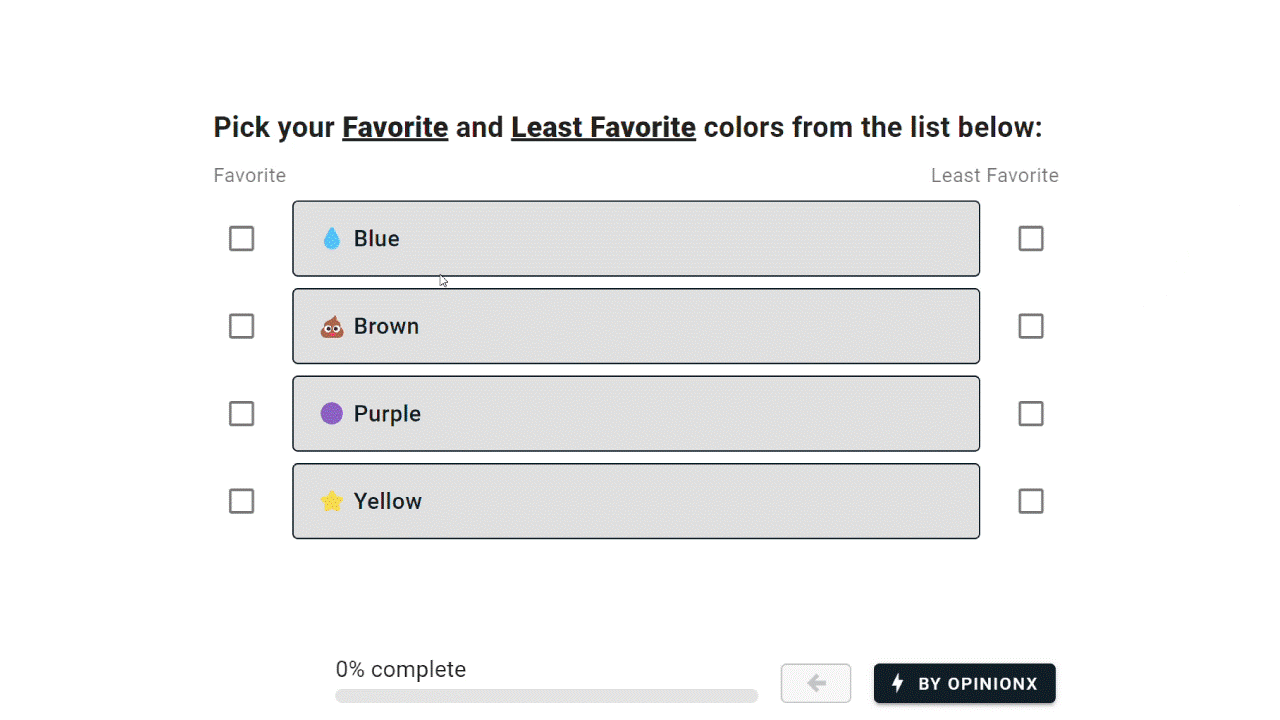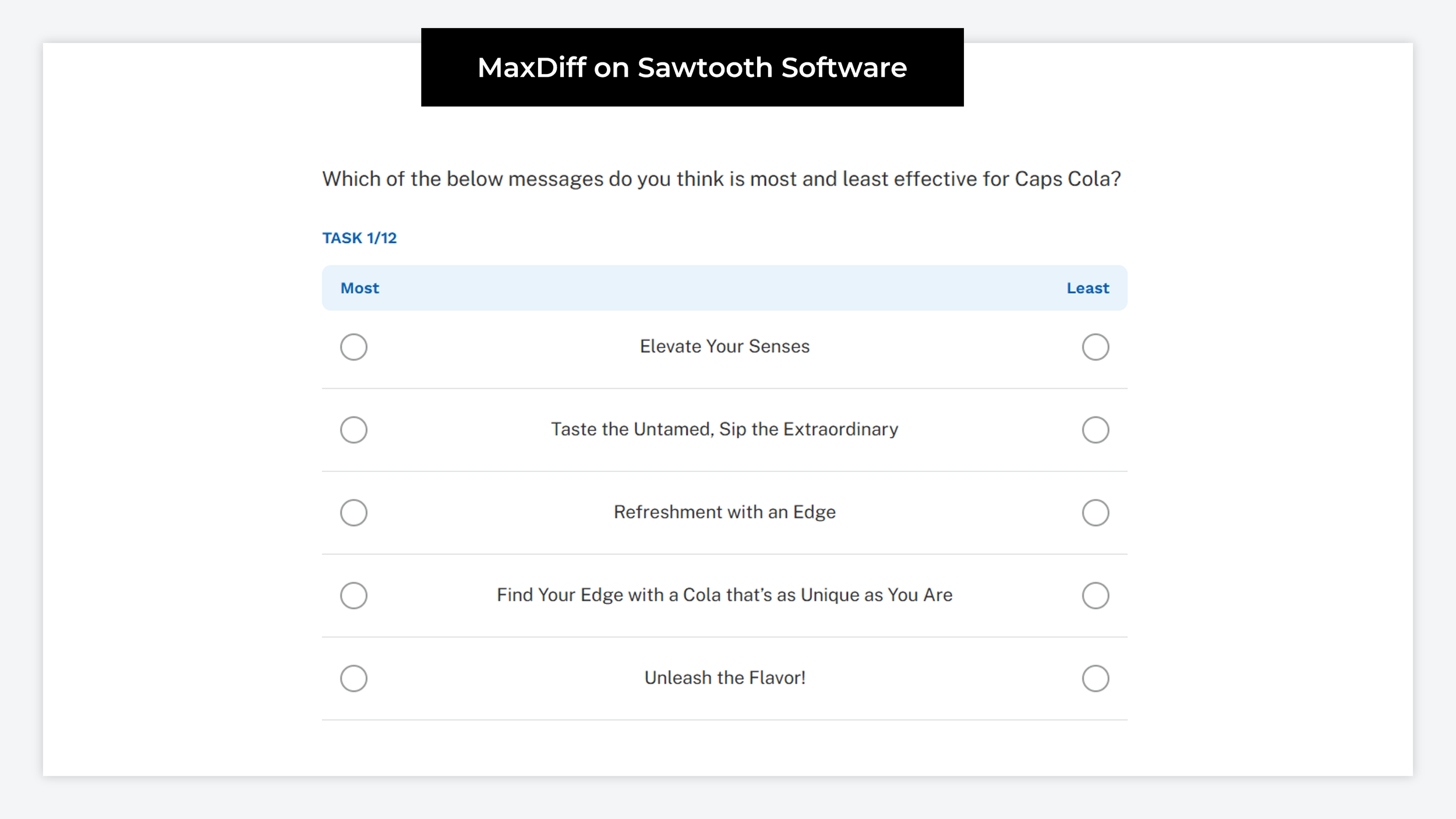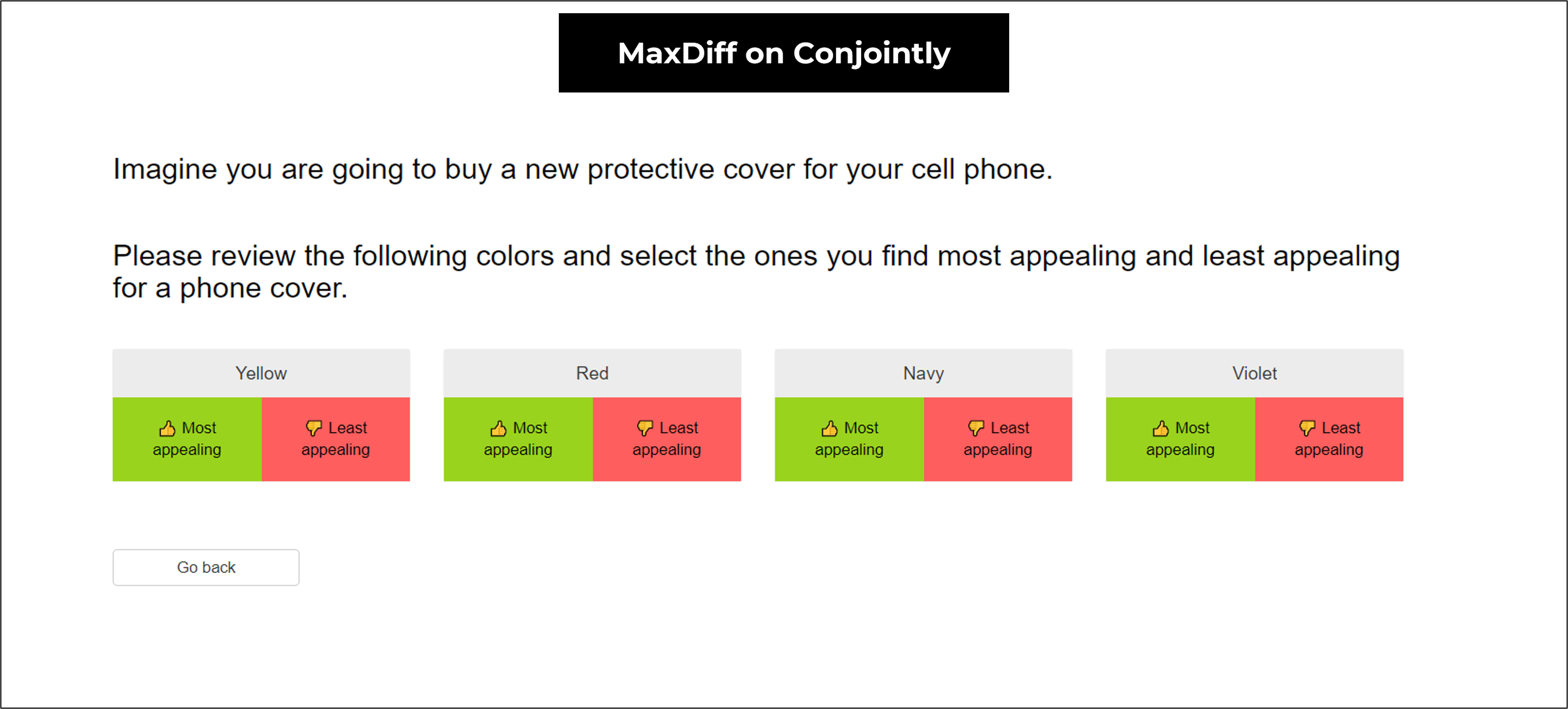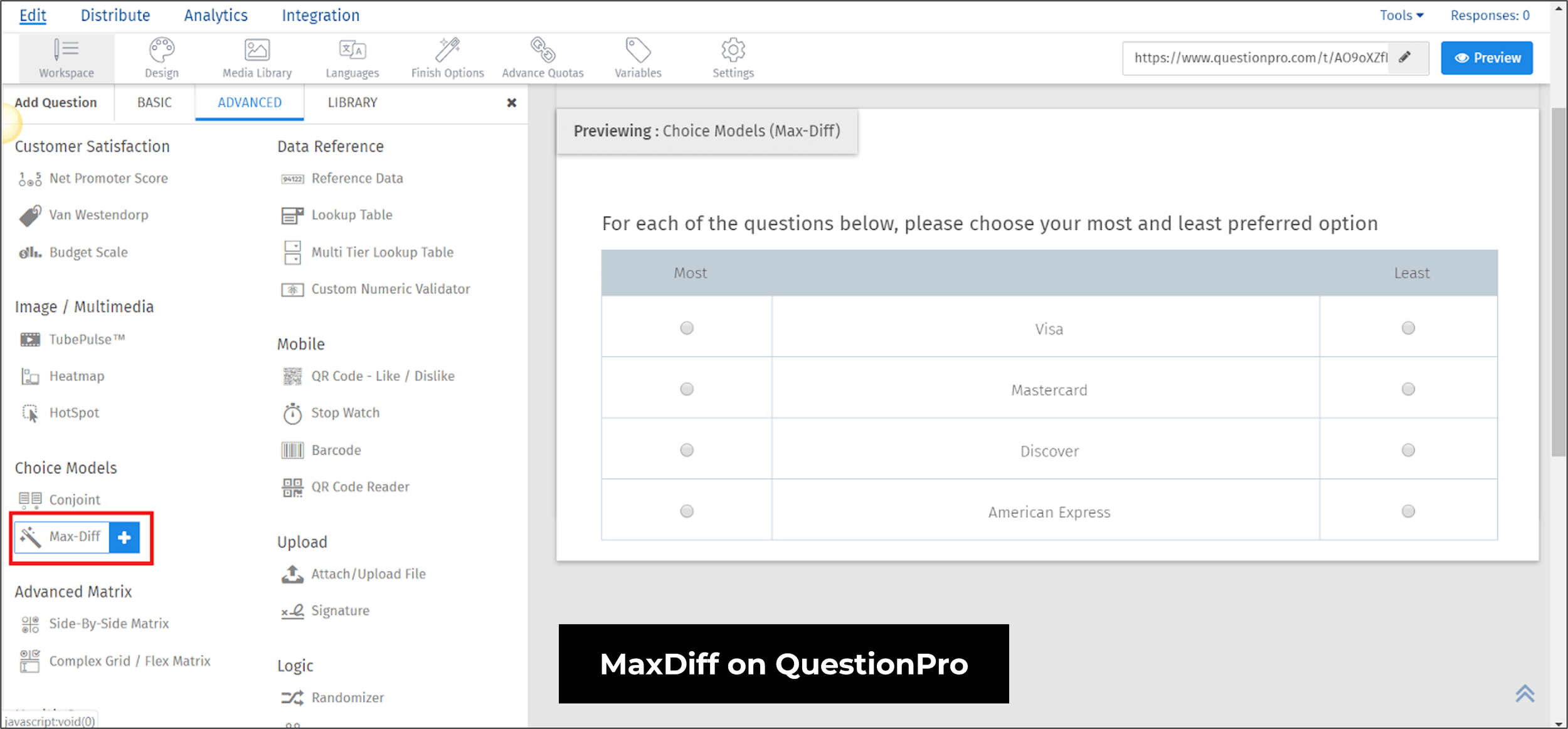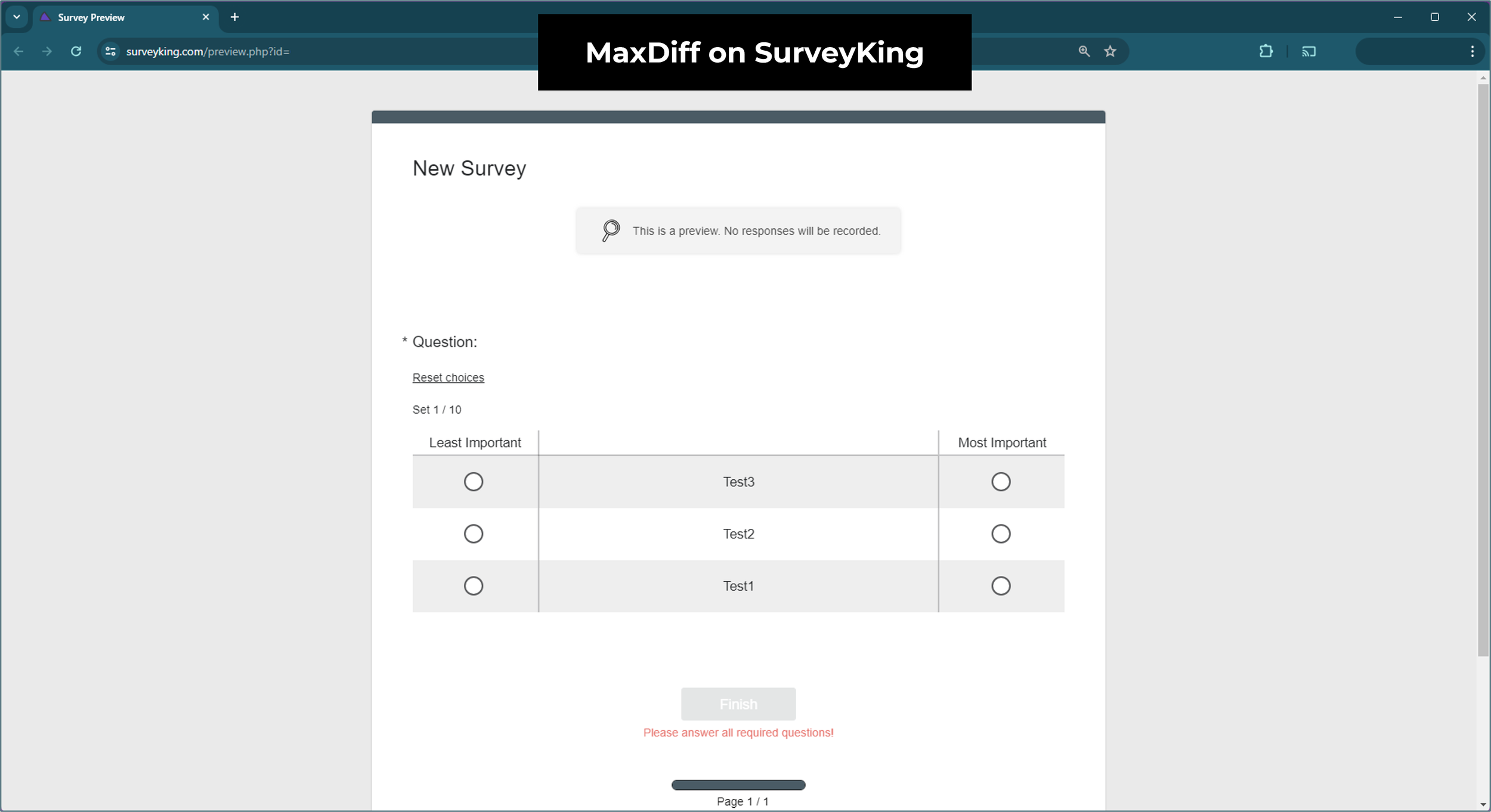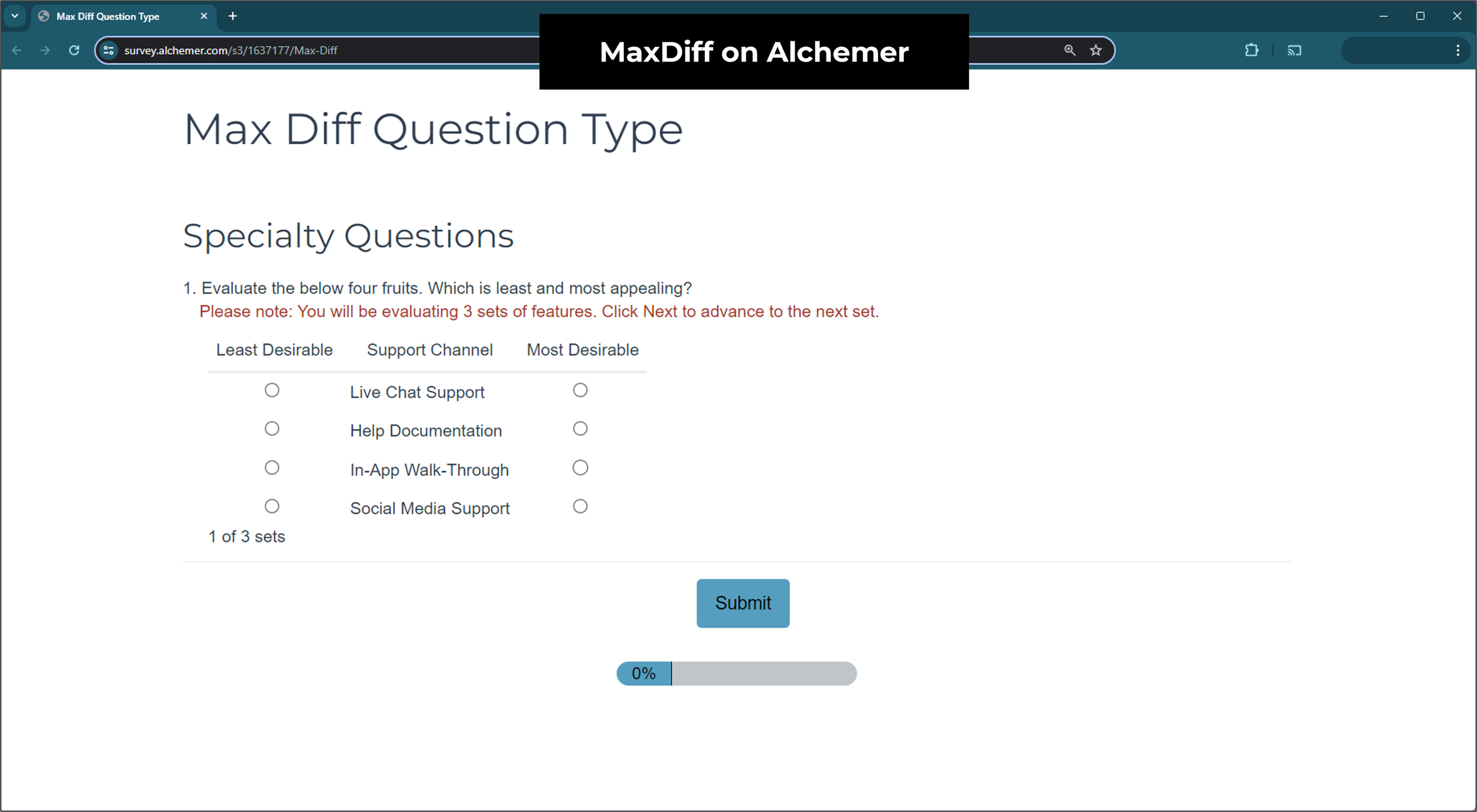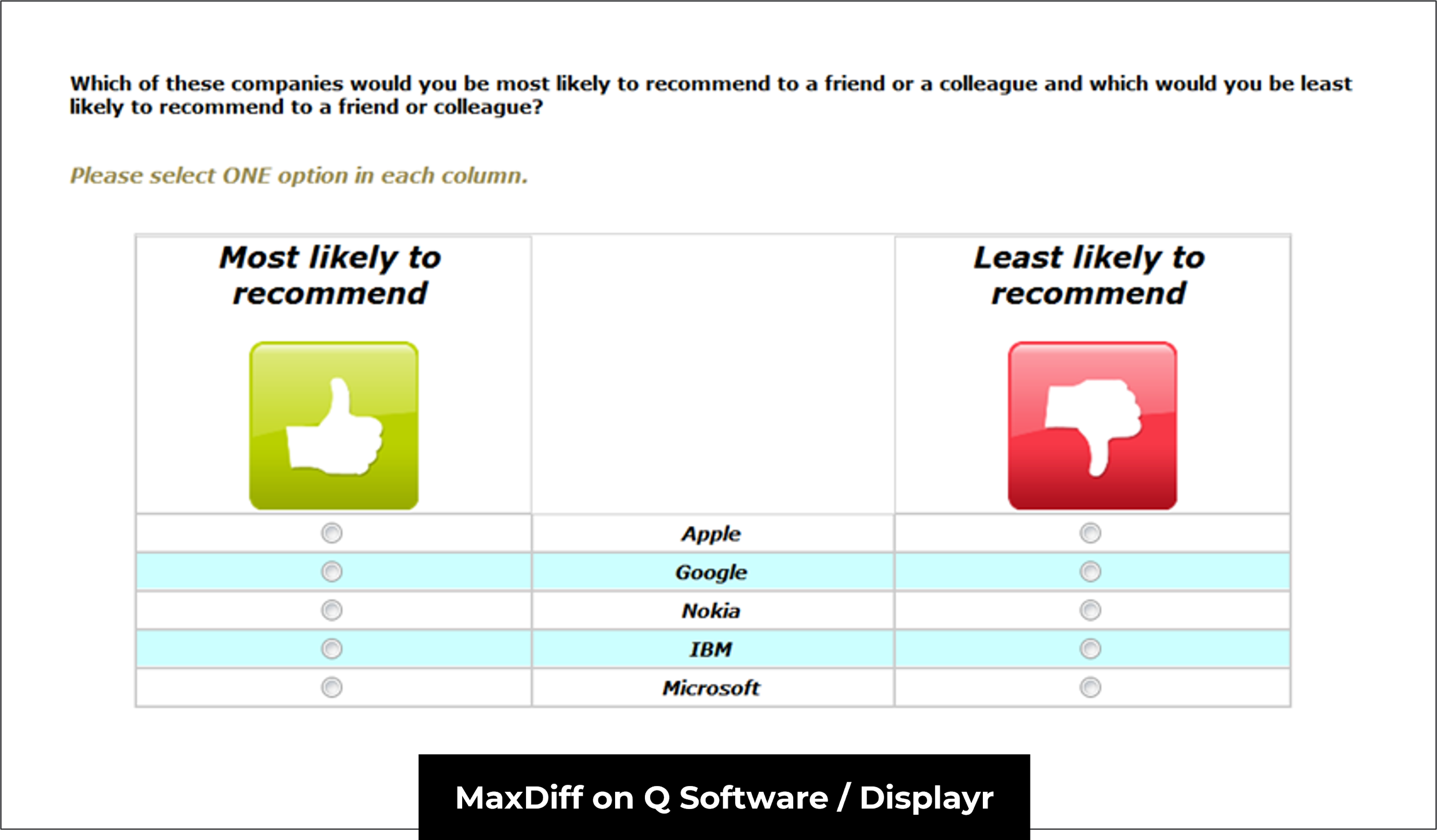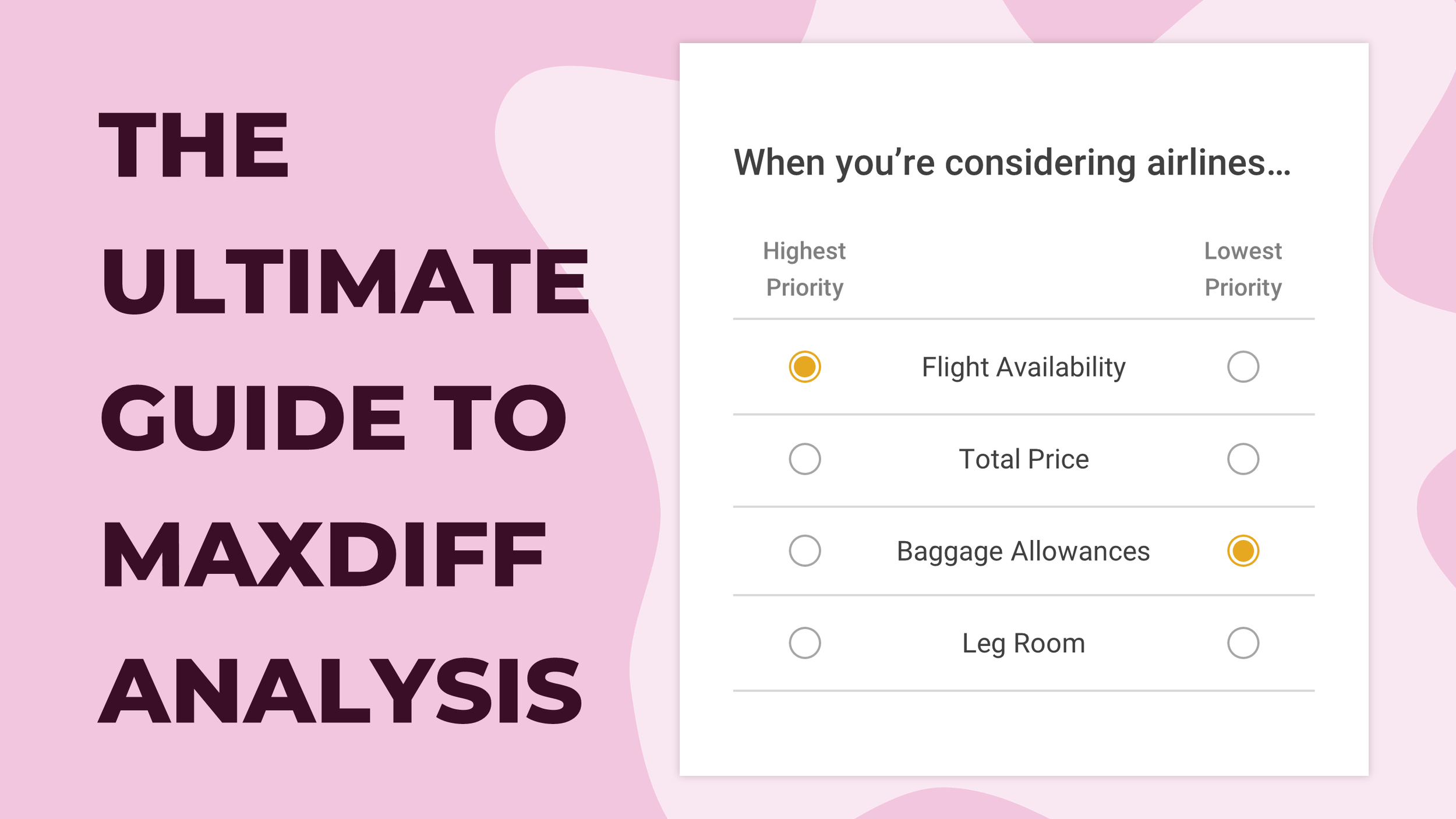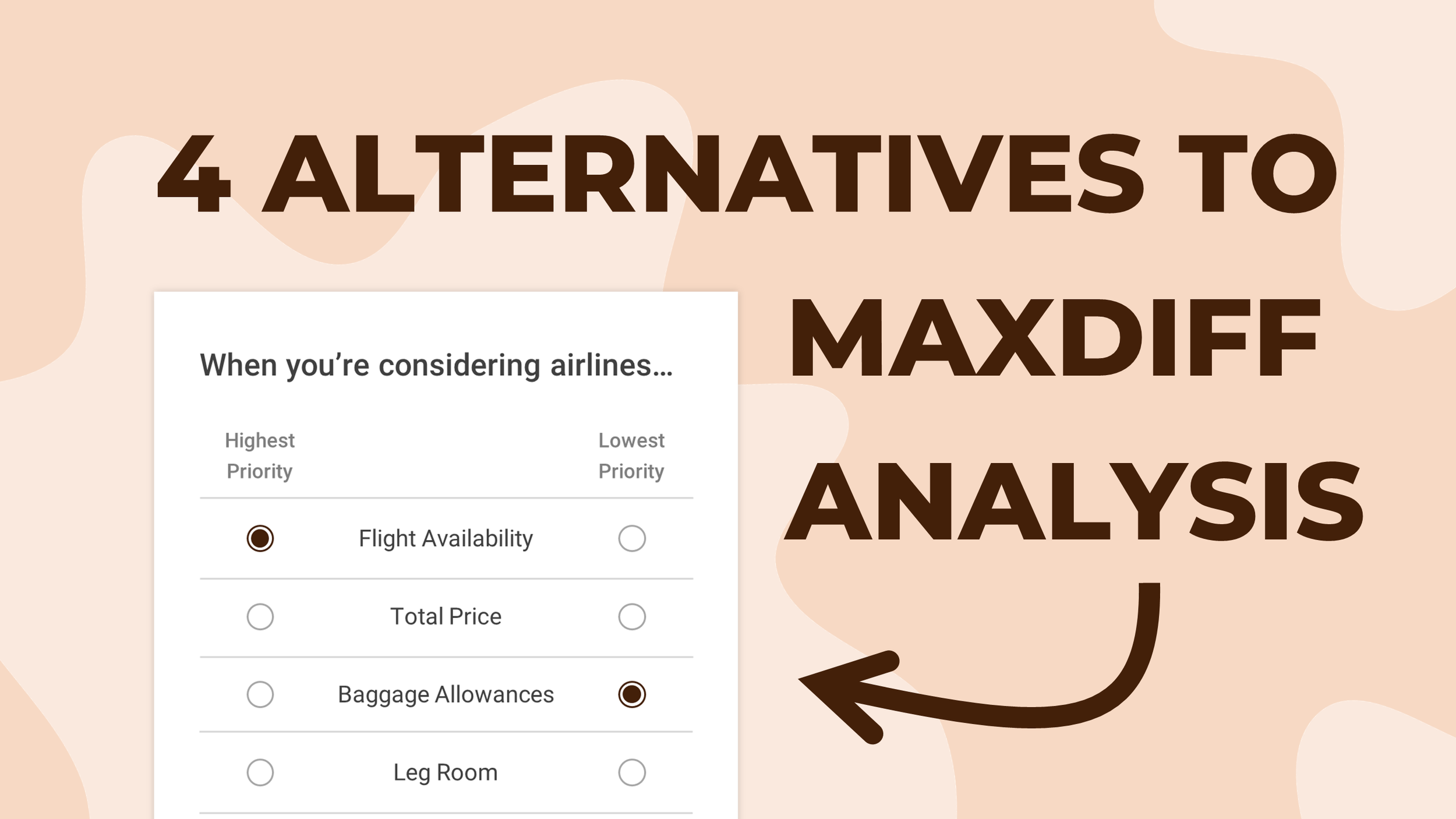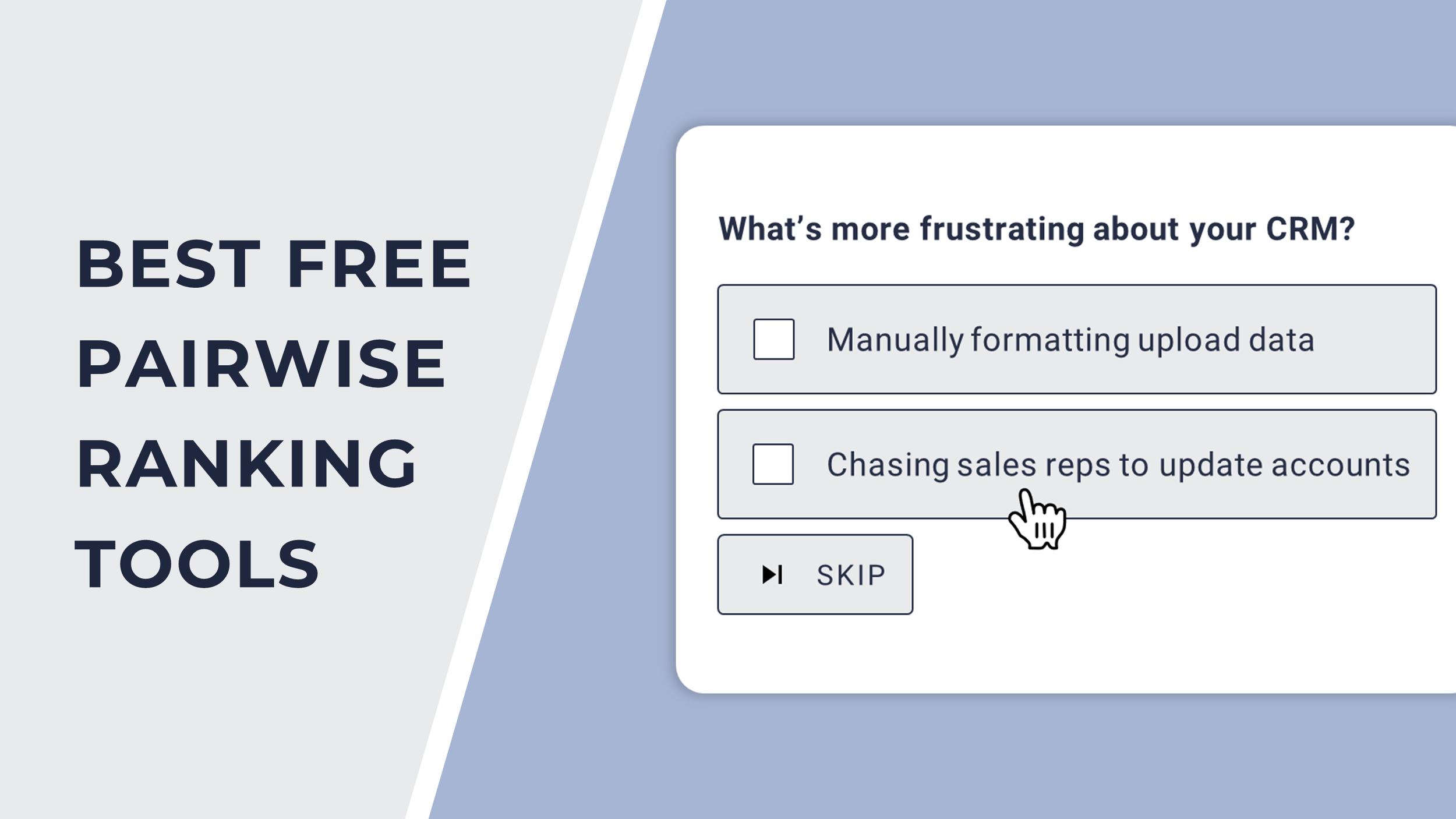Comparing The 10 Most Popular Tools For MaxDiff Analysis
Can’t seem to figure out which tool is right for your MaxDiff Analysis survey? I tested out the 10 most popular MaxDiff Analysis tools to see which ones have a free version, how their survey design looks, and whether they offer the analysis features required for MaxDiff data.
Wait, what is MaxDiff Analysis?
MaxDiff Analysis measures people’s priorities by asking them multiple times to choose the best and worst option from sets of 3-6 statements. Each time the respondent finishes, a new set of statements from the full ranking list is shown. Check out our Ultimate Guide to MaxDiff Analysis for more explainers and examples.
⬆️ interactive example of a MaxDiff Analysis survey built on OpinionX
— — —
What Are The Most Popular Survey Tools For MaxDiff Analysis?
1. OpinionX ✅
OpinionX is a free survey tool for ranking people’s priorities. It comes with a MaxDiff Analysis question type called “Best/Worst Rank” which you can use on the free version of the tool. There are no usage-based limits on the free version of OpinionX, which means you can create unlimited surveys with unlimited questions, engage unlimited participants, and invite unlimited teammates to view your interactive results — all without paying a single dollar.
Sounds too good to be true? Here’s a full breakdown of OpinionX’s free and paid plans:
OpinionX Free: The free version allows you to choose how many sets each participant must vote on (it comes with a built-in robustness calculator to help you figure out the right number for this depending on your expected amount of participants). And, as previously mentioned, the free tier allows for unlimited surveys, questions, participants, and teammate seats. The only limitations for free MaxDiff surveys on OpinionX are that (a) you can only show 3 options per voting set and (b) the labels are fixed as “Best” and “Worst” (these two limitations are editable on any of the premium tiers).
OpinionX Analyze: The Analyze tier unlocks OpinionX’s survey setup customizations and premium analysis. On the setup side, this includes the number of options per voting set, custom “Best” / “Worst” voting labels, hiding the skip button, and adding conditional branching logic. For analysis, you can export your results, filter the ranked results by group, create segmentation analysis tables, and more.
The free version is designed to suffice 90% of projects and be fully usable without any subscription. For the 10% of projects that need advanced features (typically teams conducting customer research), OpinionX’s paid subscriptions are cheaper than any other tool on this list. You can pick between yearly subscriptions for unlimited surveys and unlimited teammate seats in your shared workspace, or a cheaper pay-per-survey model with no subscription while still getting unlimited participants.
Screenshot of the results table on a Best/Worst Rank survey hosted (via OpinionX)
OpinionX is used by tens of thousands of teams around the world, including researchers at companies like Google, Amazon and Microsoft, as well as national governments and Ivy League academics. OpinionX is the only research tool that offers free MaxDiff Analysis surveys.
⬆️ Example of a free image-based MaxDiff survey on OpinionX ⬆️
— — —
2. Forsta ❌
Forsta (the brand that emerged from the mega-merger between Confirmit, FocusVision Decipher, and Dapresy) offers a MaxDiff Analysis survey format as part of their “dynamic questions” range. I turned over every rock on the internet to find (1) a live demo or (b) a rough price range for Forsta but I couldn’t find anything in the end. Seems like you’ll have to go through a full sales qualification conversation if you want to find this out for yourselves (🚩), good luck to the brave souls willing to go through that 🫡
3. Qualtrics ❌
Qualtrics has a MaxDiff question format but it is not available for use without an existing PX or EX premium subscription or if you have a CX license that includes the journey optimizer. Even with that, you’ll still need to make an additional purchase via your Account Executive to unlock MaxDiff on Qualtrics.
Considering a base-level CX license costs $5,000/year for one CoreXM user, plus $1 per respondent, and Conjoint starts at an additional $8,000/year add-on, it would appear that MaxDiff on Qualtrics would be a $10,000 entry price plus respondent fees for a new customer.
I managed to get access to a test version of MaxDiff Analysis on Qualtrics, which shows a dummy survey that is already filled in with sample data (screenshot above). The dummy survey seems to show that the MaxDiff voting sets are fixed and consistent for every participant, which is weird and not so useful for almost any MaxDiff research project.
4. SurveyMonkey ❌
SurveyMonkey added a MaxDiff question type in October 2023 called “Best-Worst Scale”. Their pricing page shows that it is available on all paid plans, but via a friend’s premium account I was shown that it is only available if I upgrade to Team Premier (the most expensive plan) starting from $2700/year ($75/month x 3-seats minimum x 12-month upfront only). Hard to know which is true, as the information about this feature from SurveyMonkey is contradictory and inconsistent.
Unfortunately, after searching high and low (pun intended) for literally a single example of someone even mentioning it online, I could not find a single screenshot of what their “Best-Worst Scale” actually looks like. Based on an obscure Reddit comment I found, it seems like maybe one person used it in December 2023, but that survey has since been closed so I couldn’t take a look for myself.
Honestly it seems suspicious that not a single person has mentioned this on the internet other than the press release announcing its launch — based on SurveyMonkey’s usage stats 4.2 billion questions have been answered since then and somehow nobody has screenshot or posted anything about this??? SurveyMonkey doesn’t even have any screenshots on their own help center article about this question type, they decided to use text tables instead (screenshot above).
So very weird… My guess, based on the original press release, is that this is a feature of their Market Research Enterprise Solutions range, which would definitely cost a lot more than the stated $2700/year price tag. Hopefully someone can confirm to me whether this actually exists on the self-service product and isn’t just some sort of fake-door test from the PM team there?
5. Sawtooth Software 🟠
Sawtooth Software is a provider of digital market research solutions. Founded in 1983, the company focuses on academics and market research organizations and offers research expertise as an additional available service. The company is best known for
Sawtooth Software is particularly suited to teams looking for deeper technical analysis functionality. It comes with the most advanced statistical testing, making it particularly useful for data scientists and quantitative experts. For example, Sawtooth offers a proprietary version of MaxDiff Analysis which they call “Bandit MaxDiffs” — it leverages Thompson Sampling to algorithmically adapt choice selection based on votes to date for each subsequent participant comparison (this is only available on the Premier tier, which is Sawtooth’s desktop application “Lighthouse Studio”).
Sawtooth Software costs $4500/user/year, with no monthly subscription available. You can create MaxDiff surveys on Sawtooth Software for free but it is limited to 50 respondents. You can also request a demo of their Lighthouse Studio product (a Windows-only desktop application) from their sales team if you want to learn more.
6. Conjointly ❌
Conjointly is an advanced market research platform that specializes in (yep, you guessed it) conjoint analysis software. A standard subscription for Conjointly includes a MaxDiff Analysis survey format for a base rate of $1795/user/year, however it does have quite an unorthodox user interface for voting as you can see in the screenshot above. It is worth noting that Conjointly is an advanced tool and you will likely need additional support services if you haven’t used something like it in the past.
7. QuestionPro ❌
QuestionPro is another of the big survey platforms. It doesn’t meaningfully differ much from products like SurveyMonkey in functionality or price, it’s just another alternative really. QuestionPro offers MaxDiff and Conjoint Analysis questions only in their most expensive tier, which is called “Research Suite” and is available by custom quote only. However, their “Workplace” product starts at $5,000/year, so it is fair to assume that the Research Suite is minimum $10,000/year or more.
8. SurveyKing 🟠
SurveyKing offers a survey platform with a wide range of question types for a low price. Free users can create a test MaxDiff survey, however you can only add three ranking options, so really it’s just a preview of the survey design and can’t be used to actually rank anything. Strangely, there’s nothing preventing the same set of options from appearing many times for the same participant on SurveyKing, which is a red flag for survey usability and data integrity. To unlock MaxDiff for actual survey use, you’ll have to upgrade to the premium version for $19/user/month (which does come with a limited number of responses per month).
9. Alchemer ❌
Alchemer (formerly SurveyGizmo) is a survey platform that, in the company’s own words, “provides tools that rival Qualtrics at a price point closer to SurveyMonkey”. Alchemer offers a MaxDiff Analysis question type but it is only available on their “Full Access” plan (their most expensive tier) starting at $1895/user/year. There is no free trial available and “Full Access” is only for up to a maximum of 3 users — beyond that you’ll have to negotiate a custom enterprise contract.
10. Q Research Software / Displayr ❌
Q Research Software is a data analysis and reporting tool designed specifically for traditional market researchers. The tool is part of Displayr’s portfolio of data products. Q Research offers specialized functionality for this customer segment such as automated data cleaning, formatting, and statistical testing. Unfortunately they don’t have a free tier or even a publicly-available demo of their MaxDiff tool — you must purchase either their Standard License ($2235/year) or Transferable License ($6705/year) before getting your hands on it.
— — —
Conclusion: Only One Free MaxDiff Tool
There is only one tool that offers free MaxDiff Analysis surveys and that is OpinionX. It comes with everything you need to get your first MaxDiff survey up and running — from the built-in calculator to make sure you get a robust sample size to the advanced segmentation for analyzing your maxdiff results. Try it out today, for free, for your next ranking exercise, user research project, or prioritization sprint:
— — —
Not ready to start your MaxDiff survey?
Learn more about MaxDiff in our Ultimate Guide to MaxDiff Analysis, which is full of useful info like real examples of MaxDiff research projects, interactive demos, formulas for calculating ideal sample size, and more.


